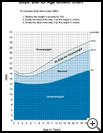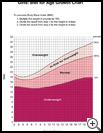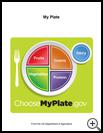
Weight Management: Teen Version
Why is weight so important?
People who are overweight or obese have many more health problems including heart disease, diabetes, and high blood pressure. It is important to try to keep a healthy weight and eat good foods. Your weight is determined, in part, by your genetics. If your parents and close family members are overweight, you have a greater chance of being overweight yourself. Don't let this be a reason to give up! Not overeating and getting plenty of exercise may allow even those with a strong family history of being overweight to have a weight that is in a healthy range.
What is a healthy weight?
The number you see on the scale doesn't necessarily tell you whether you need to lose weight. That's because two people of the same height and weight can have different bone structures. They may carry different amounts of muscle and body fat. To find out if you are at a healthy weight, your healthcare provider usually calculates your body mass index (BMI). BMI uses your height and weight to estimate how much fat is on your body. Once you know your BMI, you can chart it on a BMI for Age growth chart to see if you are a healthy weight.
If your BMI for your age is in the Overweight or Obese range on the growth chart, you are overweight or at risk for being overweight as an adult. BMI is not the only tool for evaluating your risk for being overweight. Your healthcare provider needs to look at other factors too.
If you feel like you are gaining too much weight and are in or getting close to the at risk ranges, it is a good time to start working on eating a healthy diet and finding a physical activity that you enjoy and will do often.
What are the nutrition basics?
Improve your daily diet by eating:
- More fruits and vegetables. Fill half your plate fresh fruits, vegetables and salad. This helps curb your hunger without adding too many calories.
- 3 cups of fat free or low-fat milk or milk products (1 cup yogurt or 1 and 1/2 ounces of cheese is equivalent to 1 cup of milk)
- At least 3 servings of whole grains a day. Whole grains include whole wheat, whole oats, whole-grain corn, brown rice, and whole grain barley.
What are some simple rules to live by?
Use the ChooseMyPlate method to eat a balance of healthy foods in the right amounts.
The ChooseMyPlate method divides the plate into 4 food groups: fruit, vegetable, grains, and protein. You can use this plate to choose foods for breakfast, lunch, and dinner. Simply fill half of a 9-inch plate with fruits and vegetables. The other half of the plate should be split between starches (such as whole grains and starchy vegetables like potatoes) and lean proteins, like lean meat, beans, and peas. A cup of low-fat or skim milk or yogurt on the side is ok.
Reduce portion sizes
Unfortunately "supersizing" is a common practice and many of us don't even know what a reasonable portion size should be. Even if you just order off a regular menu, portions can be huge, such as drinks, sandwiches, pasta, and muffins. A simple starting point is to cut your regular portions down by half. When eating out, take half your meal home. Order the small sizes or share the high-calorie items with a friend. Eat slowly, and you may be surprised to find that you are totally comfortable with the smaller portions.
Reduce saturated fat and trans fats
Saturated fat and trans fat may be the biggest source of extra calories in a teen's diet. These calories not only lead to weight gain, but increase your risk for chronic conditions, such as heart disease. Common food pitfalls for teens include:
- fast food hamburgers, cheeseburgers, pizza, crispy chicken patties, chicken fries and nuggets, French fries, breakfast sandwiches with cheese, bacon or sausage, and deep fried dessert pies (Homemade versions of fried foods are healthier if chicken is skinless and food is fried in canola or olive oil, but fried food still packs a lot of extra calories.)
- whole milk and whole milk desserts such as milkshakes and ice cream
- high fat lunch meats, like bologna, salami, and hot dogs
- butter, sour cream, creamy salad dressing, full fat cheeses, heavy sauces, and baked goods
Take time to think about healthier versions of these favorites. You can:
- choose a grilled chicken sandwich, veggie burger, or grilled chicken salad instead of a hamburger
- order veggie pizza with half the cheese
- try skim milk desserts and reduced fat cheeses
- eat low-fat or fat-free dressings
- use mustard instead of mayonnaise
- eat tomato-based sauces rather than cream sauces
- avoid bacon and sausage.
You'll need to get the whole family involved. When shopping, buy leaner varieties of animal products such as low fat cold cuts, lean fresh meats and non-fat dairy products. Grill, bake, broil, steam, and stir-fry instead of frying. You can bake your own cakes and cookies using recipes with less fat and sugar. Remember even these modified versions still have calories and need to be eaten in normal portions like any other treat.
Do not skip meals
Get into the habit of eating 3 regular meals (keeping smaller portions in mind) and a few snacks in between. Skipping meals can lead to increased hunger and uncontrolled overeating later.
Snack on fresh fruits, vegetables, and lean yogurt
Teens rarely eat enough of these nutritious foods. Rich in vitamins and minerals, fruit and veggies help fill you up with unprocessed carbohydrate and fiber. Non-fat dairy products are high in calcium and protein and may help you stay at a healthy weight. Fresh fruit is a perfect anytime snack. Try raw vegetables like carrots, broccoli, cauliflower, and snap peas or prepare a small salad or bowl of lower salt vegetable soup; choose non-fat or low-fat yogurt. A small bowl of low-sugar cereal with milk and sliced fruit is another great idea. Plan to take snacks with you so vending machine snacks will be less tempting.
Drink water instead of sugary soft drinks, energy drinks, and sodas
Today's teens drink far too much soda and the portions keep getting larger. Soda is really just sugared water. It packs about 250 calories per 20 ounce bottle. Drinking more soda is one of the top 3 causes of teen obesity. Energy drinks are also very popular. They often have as much sugar and calories as soda and more caffeine. Too much caffeine can keep the body from absorbing calcium. This is especially true if you do not get enough calcium in your diet. Drinking too many soft drinks (diet or regular) may also have a negative effect on bone development, especially when these drinks replace milk.
Depending on body size and level of activity, we need about 8 cups of fluid per day. Some of this comes from foods (like fruits and vegetables) and the rest from liquids. Try to get into the habit of drinking more water. It will keep you hydrated, quench your thirst, and fill you up. Carry bottled water with you and drink it throughout the day. Be sure to recycle your water bottles.
It is all right to get some of your needed fluids from drinks other than water. Non-fat and low-fat milk are mostly water and always a good choice. Juices also have a high water content, but also have a lot of calories. Limit fruit juice to no more than 1 cup per day. It is better to get your fruit servings from whole fruit rather than juice. You can choose diet soda or no calorie fruit flavored drinks sweetened with NutraSweet, Stevia, or Splenda sometimes.
Do something physically active every day
Get some moderate to strenuous activity for 60 minutes each day. It may take some time to get to this level of fitness, but it is a good goal. It is OK to start out slowly and work your way up.
Forgive Yourself
Losing weight is hard work. If you go off your diet for one meal or one day, don’t let it affect the next day. It happens to everyone. Just get back on track. Remember that exercise can lift your mood and keep you positive.
You can get more information about healthy eating from the ChooseMyPlate Web site at: http://www.choosemyplate.gov/
Last modified: 2011-08-08
Last reviewed: 2011-07-05



